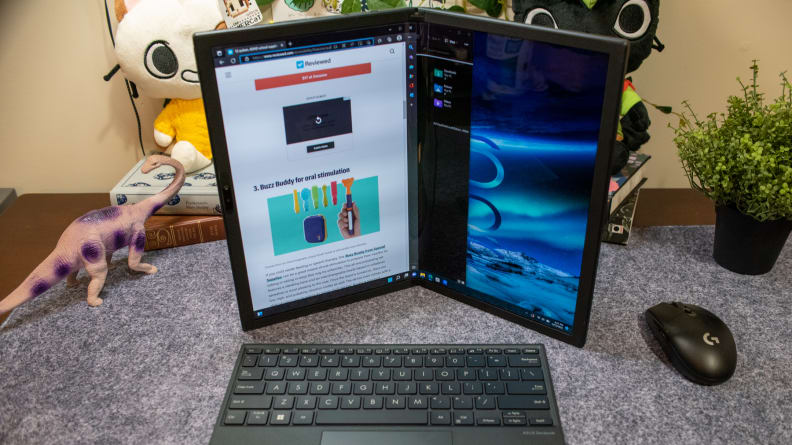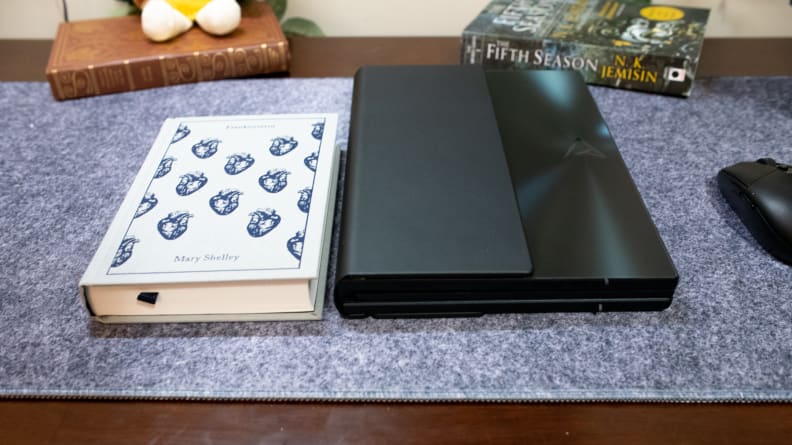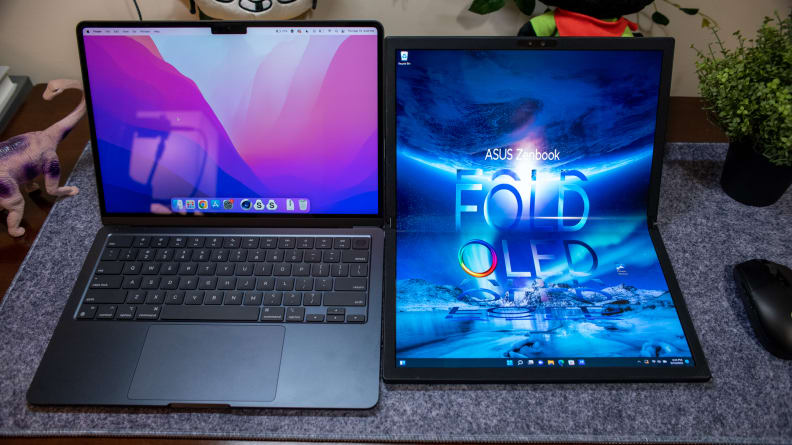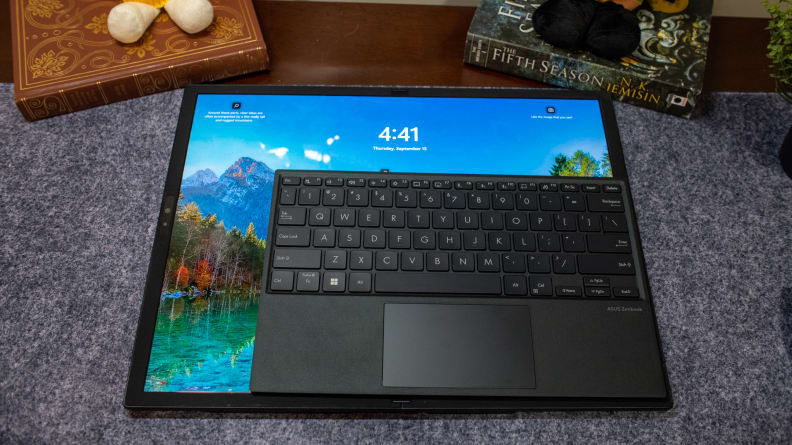Cons
-
Lacking big features
-
Weak performance
-
Bulky
Asus made a gorgeous, color-accurate, 17-inch touchscreen with no stylus support.
What would you add to your wardrobe if you had a little extra money? We’re giving away two $250 Nordstrom gift cards, so let’s find out. Enter to win between now and Sept. 30, 2022.
About the Asus Zenbook Fold 17 OLED
Here are the specs of the laptop we tested:
- Processor: Intel Core i7-1250U
- Graphics: Intel Iris Xe integrated graphics
- RAM: 16GB DDR5
- Storage: 1TB M.2 NVMe SSD
- Display: 17.3-inch, 60Hz, 2560 x 1920 FOLED display with 500 nits HDR peak brightness and 100% DCI-P3 color gamut, Pantone validated
- Ports: 2 x Thunderbolt 4; 1 x 3.5mm headphone jack
- Wireless connectivity: WiFi 6E, Bluetooth 5
- Camera: 5MP camera with IR
- Battery: 75Whr Li-ion battery
- Weight: 3.31 pounds
- Size: 37.85 x 28.76 x 0.87 inches
- Warranty: 1-year limited warranty
Currently, the Asus Zenbook Fold 17 only comes in one configuration and it retails for $3,499.
What we like
17 inches of foldable OLED

Credit: Reviewed / Adrien Ramirez
The impressive quality on the huge 4:3 OLED display didn’t falter even after being folded in half.
Why get an all-display laptop or tablet if the display sucks? Thankfully, that’s not the case with the Zenbook Fold 17 OLED, which is a 17-inch tablet that folds in half. It’s bright, and it’s colorful, and when unfolded it’s more display than tablet due to its massive size. The OLED technology helps the colors truly pop and come to life on the massive 4:3 display, which covers the full P3 color gamut. The fidelity of the 2160 x 1920 screen is nothing short of mesmerizing.
While the display is rated for 500 nits of peak HDR brightness, our testing fell short of that. In testing, we measured a peak brightness under 300 nits—but it feels brighter thanks to the dark blacks of the OLED screen.
Because it’s a fold display, there are a number of ways you can use the laptop. You can lay it out flat and use it as a 17-inch tablet, fold it in half like a clamshell laptop and only use the top half of the display, or you can use both halves of the display as if they were two separate displays. You could even hold it like a book, although its size makes it awkward to do so.
For the most part, the Zenbook Fold transitions smoothly between display modes, whether it’s flipping from vertical to horizontal, covering the bottom half with the keyboard, or anything in between. It did get stuck in vertical or horizontal mode sometimes, but it wasn’t often and it was a quick fix with restarting the laptop or manually selecting the display layout mode within the included ScreenXpert display software.
The included keyboard and folio cover are excellent
The keyboard insert can either be near the Zenbook Fold or resting on half of the display to feel like a classic laptop. The keys feel responsive and accurate, with the flat chiclets closely resembling those on the normal Zenbook laptops. Typing on the keyboard was usually a seamless experience, although it did sometimes lose the Bluetooth connection after being idle for long periods of time.
Additionally, the laptop comes with its own carrying case, which is thick enough to protect the laptop from soft impacts. It fits snugly in the fabric, and together the bundle fits easily into a large tote or backpack. The gray and black design is a little unassuming, but its cleanliness also gives it sophistication.
Stylish and surprisingly compact design

Credit: Reviewed / Adrien Ramirez
The Zenbook Fold 17 OLED isn’t a massive machine that you’ll have to cart around–it measures in at 13-inches when folded and is only over an inch thick.
When you envision a 17-inch laptop, maybe you imagine a heavy machine that’s more concrete slab than laptop. But the whole theme of foldable technology is compactness, so that’s not the case with the Zenbook Fold.
When folded in half, it’s about the size of a 13-inch laptop and a little over an inch thick, which makes it easy to slip into any mid-sized bag or backpack. The magnesium alloy and leather body keep the package lightweight at under four pounds, and the screen folds in such a way that it leaves a gap in the middle, conveniently large enough to tuck in the wireless keyboard.
It all looks more like a fancy business journal than it does a piece of tech when not in use.
What we don’t like
Performance is weak for an expensive laptop

Credit: Reviewed / Adrien Ramirez
The Intel Core i7-1250P fell flat when it came to running smoothly while batch photo editing and 3D graphics rendering.
Right now, the Zenbook 17 Fold OLED only comes in one configuration, and most laptops with its specs cost well below $2,000. If you were hoping for a video editing powerhouse, you’ll be disappointed here.
The Intel Core i7-1250P processor can keep up with casual office work, from keeping dozens of Chrome tabs open to writing a long paper, but it struggles with more intense work like batch photo editing or 3D graphics rendering. The humble performance stings doubly when you compare the kind of power you could expect from a $3,500 desktop or gaming laptop with flagship hardware.
The Acer Predator Triton 500SE gaming laptop and Apple MacBook Pro 16 M1 Max are two flagships that show what you can get with $3,500. In our multicore processing benchmarks (Geekbench 5 and Cinebench R23), both the Triton 500SE and MacBook Pro 16 ran anywhere from 100% to 200% faster than the Zenbook Fold. Likewise, graphics performance crushes the Zenbook Fold 17.
As for battery life, it’s nothing special for a premium laptop. We test battery life on laptops by running through 20 Chrome tabs on a laptop set to 200 nits brightness from full charge until it’s totally drained. At about six hours, the Zenbook 17 Fold OLED sits well below the premium laptop average of eight hours but also well above what it could have been with such a large display.
Lacking big features
You’d think such a futuristic device would have all sorts of premium perks, but there are two glaring omissions from its feature-set. The first is that the touchscreen does not support styluses.
Asus made a gorgeous, color-accurate, 17-inch touchscreen and robbed us of the joy of writing or drawing on it. The older Lenovo ThinkPad X1 Fold managed to figure out stylus support two years ago, and foldable technology has come a long way since then.
The second problem is the keyboard. It’s a wireless bluetooth keyboard—there’s nothing inherently wrong with that, but it feels wrong when the connection is finicky and you have to reset it a couple of times a day. Thankfully, you can use the onscreen digital keyboard if you’re having trouble.
You also have to charge the keyboard separately from the PC, which is just sad when a sub-$1,000 iPad can manage to keep its wireless keyboard charged just by staying connected to the main device. Adding wireless charging to the Zenbook 17 Fold’s keyboard would have truly elevated the product.
Should you buy the Asus Zenbook Fold 17 OLED?
No, its quirks dampen its novelty

Credit: Reviewed / Adrien Ramirez
Unfortunately, the price point on the Zenbook Fold 17 OLED is too steep for the weak processing times being offered.
Despite having more good things to say about the Asus Zenbook 17 Fold OLED, we still recommend you stay away from this laptop. Look, it’s a fun laptop. It’s one of the first laptops with a foldable display on the market, and what a gorgeous display it has! However, its novelty quickly wears off once you glance at its $3,500 price tag.
For the price, the Zenbook 17 Fold OLED isn’t especially fast or powerful, and it lacks stylus support despite being such a display-centric product. The laptop feels more like a proof-of-concept than some product destined for commercial success. Currently, the Zenbook 17 Fold’s only true competitor is the Lenovo ThinkPad X1 Fold, which is cheaper but not nearly as aesthetically pleasing.
More traditional premium laptops, like the MSI Summit E16 Flip, are more powerful and versatile than a foldable display laptop, but you lose out on the Zenbook 17 Fold’s 3:2 aspect ratio and massive screen real estate. This is a tantalizing product that makes the most of its technology, but it’s just too early for folding displays in laptops to make a splash.
We’re certain to see sturdier, brighter, and cheaper foldable displays in the next decade, but for now they are impractical for the average consumer. Until then, early adopters and enthusiasts might like the Zenbook 17 Fold if they can overlook its shortcomings.
The product experts at Reviewed have all your shopping needs covered. Follow Reviewed on Facebook TwitterInstagram, TikTok, or Flipboard for the latest deals, product reviews, and more.
Prices were accurate at the time this article was published but may change over time.
Meet the tester
Checking our work.
Our team is here for one purpose: to help you buy the best stuff and love what you own. Our writers, editors, and lab technicians obsess over the products we cover to make sure you’re confident and satisfied. Have a different opinion about something we recommend? Email us and we’ll compare notes.
Shoot us an email
.
